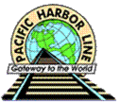History
The original Harbor Belt Line was formed in 1929 by a joint agreement of the city of Los Angeles and four major railroads: the Pacific Electric (PE) lines, the Southern Pacific (SP), the Santa Fe Railway (ATSF) and the Union Pacific (UP). Each railroad agreed to supply a quota of employees and equipment to provide switching services within a "unified zone" containing 117 miles (188 km) of track. In 1959 the employees of the Harbor Belt Line filed a dispute with the National Railroad Adjustment Board arguing that the employees of the Pacific Fruit Express were performing work on the line which was designated as work for the employees of the Harbor Belt Line. [2] The railroad also operated a joint freight agency for handling smaller station shipments. [3] PE merged into SP in 1965, [4] leaving three railroads to operate the HBL. The ATSF would also be part of a merger in 1996, forming the new Burlington Northern & Santa Fe (BNSF), and the SP and UP would merge into the current Union Pacific in February 1998.
Also in 1998, the HBL was re-organized as the Pacific Harbor Line to create a more even distribution system for shippers using the ports and the two surviving railroads (BNSF and UP). Although HBL's switching operations had been handled jointly, shippers could have problems getting their goods to or from the port depending on where an individual railroad interchanged with the HBL. The PHL aimed to resolve these issues.
Pacific Harbor Line was named the 2009 Short Line Railroad of the Year by Railway Age magazine. [5]
In July 2013, Pacific Harbor Line signed a new five-year collective agreement with the Brotherhood of Locomotive Engineers and Trainmen (BLET), which has represented workers at the company since PHL was formed in 1998. [6] A new five-year contract was signed and took effect in September 2020. [5]
On March 31, 2020, Eduardo Moreno attempted to crash a PHL train into the hospital ship USNS Mercy, which was in the Port of Los Angeles to provide Los Angeles with additional hospital capacity during the COVID-19 pandemic in California, but the train stopped approximately 250 yards (230 m) from the ship. [7]
PHL was the first railroad to have its locomotive fleet composed only of Tier II and Tier III "clean diesel" locomotives. An EMD Joule Battery Electric Locomotive arrived in 2023 for testing and demonstration purposes for 2 years. [8]
This page is based on this
Wikipedia article Text is available under the
CC BY-SA 4.0 license; additional terms may apply.
Images, videos and audio are available under their respective licenses.

